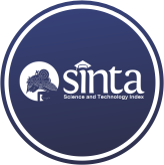Analisis Konsumsi Energi Listrik Pelanggan Dan Biaya Pokok Produksi Penyediaan Energi Listrik dengan Machine Learning
(1) Institut Teknologi Sepuluh Nopember
(2) Institut Teknologi Sepuluh Nopember
(3) Institut Teknologi Sepuluh Nopember
(4) Institut Teknologi Sepuluh Nopember
(5) Institut Teknologi Sepuluh Nopember
(*) Corresponding Author
Abstract
Full Text:
PDFReferences
. Gurenescu, 2011, Data mining : Concept and Techniques. Verlag berlin Heidelberg: Springer.
. Ian H. Witten, frank Eibe, and Mark A. Hall, Data Mining: Practical Machine Learning Tools and Techniques, 3rd ed., Asma Stephan and Burlington, Eds. United States
. Liao. 2007. Recent Advances in Data Mining of Enterprise Data: Algorithms and Application . Singapore: World Scientific Publishing
. Wu, Xindong & Kumar, Vipin. 2009. The Top Ten Algorithms in Data Mining. Boca Raton: CRC Press
. Zhang, Guazhen, Zhou, faming, etl., 2008, Knowledge creation in marketing based on data mining, Intelligent Computation Technology and Automation (ICICTA), 2008 International Conference on Page(s): 782 – 786
. Vercellis, C. 2009. Business Intelligent: Data Mining and Optimization for Decision Making. Southern Gate: John Willey & Sons Inc.
. Shukla, A. Tiwari, R., & Kala, R. 2010. Real Life Application of Soft Computing. Taylor and Francis Groups, LLC.
. Diyah, Puspitaningrum. 2006. Pengantar Jaringan Syaraf Tiruan, Penerbit Andi, Yogyakarta.
. M. DASH and H. LIU, “Feature selection for classification,” Intell. Data Anal., vol. 1, no. 1–4, pp. 131–156, 1997.
. M. Wibowo, F. Noviyanto, S. Sulaiman, and S. M. Shamsuddin, “Machine Learning Technique For Enhancing Classification Performance In Data Summarization Using Rough Set And Genetic Algorithm,” Int. J. Sci. Technol. Res., vol. 8, no. 10, pp. 1108–1119, 2019.
. A. Luque, A. Carrasco, A. Martín, and A. de las Heras, “The impact of class imbalance in classification performance metrics based on the binary confusion matrix,” Pattern Recognit., vol. 91, pp. 216–231, Jul. 2019.
. D. Kurniawan, A. Anggrawan, and H. Hairani, “Graduation Prediction System On Students Using C4.5 Algorithm,” MATRIK J. Manajemen, Tek. Inform. dan Rekayasa Komput., vol. 19, no. 2, pp. 358–365, 2020.
. S. Helal et al., “Predicting academic performance by considering student heterogeneity,” Knowledge-Based Syst., vol. 161, pp. 134–146, Dec. 2018.
. A. Khan and S. K. Ghosh, “Student performance analysis and prediction in classroom learning: A review of educational data mining studies,” Educ. Inf. Technol., vol. 26, no. 1, pp. 205–240, Jan. 2021.
. A. Namoun and A. Alshanqiti, “Predicting Student Performance Using Data Mining and Learning Analytics Techniques: A Systematic Literature Review,” Appl. Sci., vol. 11, no. 1, p. 237, Dec. 2020.
. D. H. Kamagi and S. Hansun, “Implementasi Data Mining dengan Algoritma C4.5 untuk Memprediksi Tingkat Kelulusan Mahasiswa,” J. Ultim., vol. 6, no. 1, pp. 15–20, 2014.
. X. Xu, J. Wang, H. Peng, and R. Wu, “Prediction of academic performance associated with internet usage behaviors using machine learning algorithms,” Comput. Human Behav., vol. 98, pp. 166–173, Sep. 2019.
DOI: http://dx.doi.org/10.30645/j-sakti.v6i1.424
Refbacks
- There are currently no refbacks.
J-SAKTI (Jurnal Sains Komputer & Informatika)
Published Papers Indexed/Abstracted By:
Jumlah Kunjungan :











